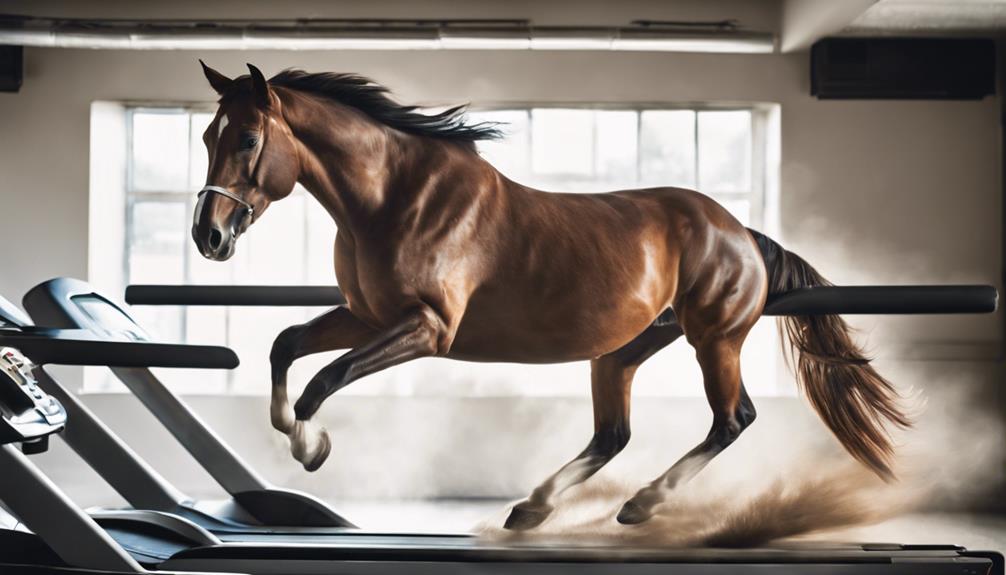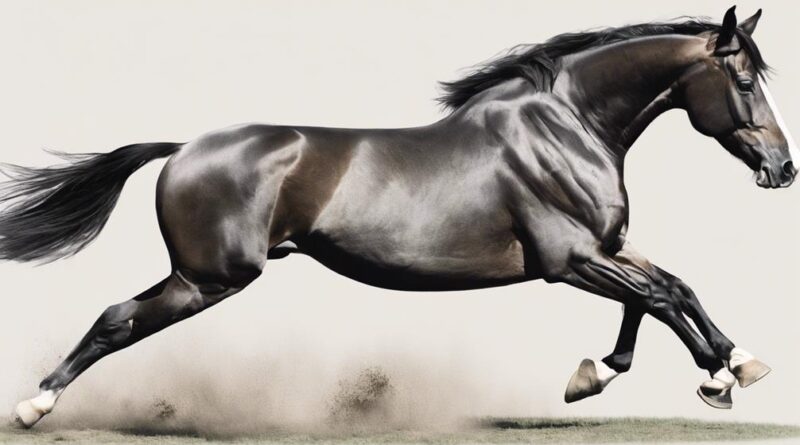Enhancing Horse Muscular Anatomy Through Effective Exercises
You may wonder if simply riding your horse is enough to keep its muscles in top shape. While riding is beneficial, incorporating specific exercises can provide targeted benefits to your horse's muscular anatomy.
From warm-up routines to cardiovascular conditioning, each type of exercise plays a critical role in enhancing different muscle groups. By understanding the importance of these exercises and how they contribute to your horse's overall strength and agility, you can optimize its performance and well-being.
Stay tuned to discover effective strategies for maximizing your horse's muscular potential.
Warm-Up Routines for Horses
To properly prepare your horse for exercise, begin with a series of dynamic stretches and light cardiovascular activities. Flexibility drills are essential to ensure your horse's muscles are ready for the upcoming workout. Incorporating stretching techniques like gentle neck stretches, leg stretches, and trunk rotations can help prevent injuries and improve overall performance. These movements help increase blood flow to the muscles, making them more pliable and less prone to strains or tears.
When performing flexibility drills, focus on gradual, controlled movements. Start with slow, deliberate stretches and gradually increase the range of motion. Pay attention to your horse's body language and adjust the intensity of the stretches accordingly. Remember, the goal is to warm up the muscles, not push them to the point of discomfort.
Incorporating dynamic stretches into your warm-up routine can also help improve your horse's agility and coordination. Leg swings, lateral flexion exercises, and shoulder circles are great additions to your pre-exercise regimen. These movements engage different muscle groups and prepare your horse for the variety of movements they'll perform during the workout.
Strengthening Core Muscles
Start incorporating exercises that target the core muscles of your horse to enhance overall strength and stability. Strengthening the core muscles is crucial for your horse's overall well-being and performance. Here are some key points to consider when focusing on core muscle development:
- Stability training: Engage in exercises that challenge your horse's balance and proprioception. Incorporate activities that require your horse to stabilize its core muscles, such as ground poles or cavaletti work. These exercises will help strengthen the core and improve overall stability.
- Flexibility exercises: Include flexibility exercises in your horse's routine to keep the core muscles supple and prevent stiffness. Stretching exercises, such as carrot stretches or gentle lateral bending, can help maintain flexibility in the core area. Flexibility is essential for preventing injuries and ensuring a full range of motion.
Exercises for Hindquarters Development
Enhance your horse's hindquarters development through targeted exercises focusing on strength and flexibility. Hindquarters power is crucial for your horse's overall performance and agility. By incorporating specific exercises into your training routine, you can effectively enhance muscle definition and strength in this vital area.
Start with exercises that target the hindquarters, such as trot poles and hill work. Trot poles encourage your horse to engage their hindquarters, promoting muscle development and coordination. Similarly, hill work challenges the hindquarters to work harder when going uphill, building strength and power in these muscles.
Incorporating lateral work, such as leg yielding and shoulder-in, can also benefit the hindquarters. These exercises engage the hindquarters while promoting flexibility and balance. Leg yielding, in particular, helps improve muscle definition in the hindquarters by requiring your horse to move sideways with controlled power.
Don't forget the importance of transitions in your training regimen. Transition work, such as moving from walk to trot and trot to canter, engages the hindquarters and encourages your horse to push off from behind, developing strength and power in the process.
Enhancing Forelimb Muscles
Engaging in targeted exercises can effectively strengthen and define your horse's forelimb muscles. To enhance your horse's forelimb muscles, consider incorporating the following key elements into your workout routine:
- Flexibility Drills: Including flexibility drills in your horse's training regimen can help improve range of motion in the forelimbs, reducing the risk of injuries and enhancing overall performance.
- Equine Massage: Regular equine massages can aid in loosening tight muscles, increasing blood flow, and reducing stiffness in the forelimbs, promoting relaxation and recovery.
- Resistance Bands: Utilizing resistance bands in your horse's exercises can add resistance to movements, targeting specific muscles in the forelimbs and promoting muscle strength and endurance.
- Plyometric Jumps: Incorporating plyometric jumps into your horse's training can help develop explosive power in the forelimb muscles, improving agility and coordination.
Building Back Muscles
To effectively strengthen your horse's back muscles, focus on incorporating targeted exercises and proper form in your training routine. Building strong back muscles is crucial for your horse's overall strength and performance. Start by implementing flexibility training to ensure your horse's back can move through its full range of motion without strain or injury. Incorporate exercises such as gentle stretches and bending work to improve flexibility and prevent stiffness.
Resistance workouts are also essential for building back muscles. Engage in exercises that target the back specifically, such as back lifts and cavaletti work. These exercises help strengthen the muscles along your horse's spine, promoting better posture and stability. When performing resistance workouts, ensure your horse maintains proper form to prevent any muscle imbalances or injuries.
Consistency is key when it comes to building back muscles. Incorporate these exercises into your regular training routine, gradually increasing the intensity as your horse grows stronger. Remember to always warm up before engaging in any strenuous activities and cool down afterward to prevent muscle soreness and aid in recovery. By focusing on flexibility training and resistance workouts, you can effectively build your horse's back muscles, enhancing their overall muscular anatomy and performance.
Agility Training for Muscular Coordination
For a well-rounded approach to enhancing your horse's muscular anatomy, consider incorporating agility training for improved muscular coordination. Agility training focuses on enhancing your horse's ability to move quickly and efficiently while maintaining balance and control. This type of training not only strengthens muscles but also improves overall coordination, leading to better performance in various activities.
Agility Training Tips:
- Balance Drills: Incorporate exercises that challenge your horse's balance, such as walking over poles or navigating obstacles. These drills help improve proprioception and stability, leading to better coordination of muscle movements.
- Speed Exercises: Include speed drills like sprints or timed laps to enhance your horse's muscle response time and agility. These exercises can help your horse develop fast-twitch muscle fibers, crucial for quick movements and rapid acceleration.
- Obstacle Courses: Set up obstacle courses that require your horse to maneuver through tight spaces or over different surfaces. This type of training enhances muscle coordination and teaches your horse to adjust its movements quickly.
- Directional Changes: Practice frequent changes in direction during training sessions to improve your horse's agility and coordination. These exercises mimic real-life scenarios where your horse needs to respond promptly to your cues.
Incorporating agility training, balance drills, and speed exercises into your horse's workout routine can significantly enhance muscular coordination, leading to improved performance and overall musculoskeletal health.
Cardiovascular Conditioning Activities

Incorporate cardiovascular conditioning activities into your horse's training regimen to enhance endurance and overall cardiovascular health. Endurance training plays a crucial role in improving your horse's stamina and ability to sustain prolonged physical exertion. Incorporating long, steady rides at varying speeds into your routine can help build your horse's cardiovascular endurance over time. These rides should gradually increase in duration and intensity to challenge your horse's cardiovascular system and promote adaptation.
Interval workouts are another effective way to enhance your horse's cardiovascular conditioning. By alternating between periods of higher intensity work and active recovery, interval training can help improve your horse's cardiovascular fitness and overall performance. For instance, incorporating short bursts of faster galloping followed by slower trotting or walking periods can simulate the demands of competition or outdoor activities.
Remember to tailor the cardiovascular conditioning activities to your horse's current fitness level and gradually progress as their endurance improves. Monitoring your horse's heart rate during workouts can provide valuable insights into their cardiovascular response and help you adjust the intensity accordingly. By incorporating endurance training and interval workouts into your horse's routine, you can enhance their cardiovascular health and overall performance in various physical activities.
Cooling Down Techniques
Implementing proper cooling down techniques is essential to help your horse recover effectively after intense physical activity. After a strenuous workout, your horse's muscles need time to relax and repair. Here are some key methods to incorporate into your post-exercise routine:
- Stretching Techniques: Gentle stretching exercises can help prevent muscle stiffness and improve flexibility. Focus on areas like the neck, shoulders, back, and hindquarters. Encourage your horse to reach and bend, holding each stretch for 15-30 seconds.
- Relaxation Methods: Create a calm environment for your horse to wind down after exercise. Allow them to walk freely, offering water and a comfortable resting area. Light grooming or a soothing bath can also help promote relaxation.
- Breathing Exercises: Practice deep breathing exercises with your horse to help regulate their heart rate and promote relaxation. Encourage slow, steady breaths by matching your breathing pattern to theirs.
- Massage Therapy: Consider incorporating massage therapy into your cooling down routine. Gentle massages can help improve circulation, reduce muscle tension, and enhance overall recovery. Focus on areas of tightness or soreness, using gentle pressure and circular motions.
Frequently Asked Questions
What Is the Ideal Frequency for Incorporating These Exercises Into a Horse's Training Routine?
To determine the ideal frequency for incorporating exercises, focus on training consistency and exercise intensity. Allow for adequate recovery periods to promote muscle adaptation.
It's crucial to strike a balance to prevent overtraining. Listen to your horse's cues and adjust the routine as needed. By being attuned to their response, you can optimize their training program for better results and overall well-being.
Are There Any Specific Exercises That Should Be Avoided for Horses With Pre-Existing Muscular Injuries?
When dealing with horses with pre-existing muscular injuries, it's crucial to be cautious about exercise selection. Some exercises may aggravate the injury, hindering recovery. Avoid high-impact activities that could strain the affected muscles further.
Instead, focus on gentle rehabilitation techniques and prevention methods to promote healing and prevent future injuries. Tailoring the training routine to suit the horse's specific needs is key to injury prevention and successful recovery.
How Can a Horse Owner Assess Their Horse's Progress and Muscular Development Over Time?
To monitor your horse's progress and track muscle development, observe their performance during training intervals. Look for changes in strength, endurance, and overall body condition.
Assess muscles regularly to pinpoint areas needing improvement. Keep a training log to record milestones and setbacks.
Are There Any Specialized Equipment or Tools That Can Enhance the Effectiveness of These Exercises?
To boost exercise effectiveness and muscle development, specialized equipment and training tools can be game-changers. They help target specific muscle groups and enhance performance.
From resistance bands to specialized saddles, these tools can take your horse's training to the next level. By incorporating them into your routine, you can see significant improvements in your horse's muscular anatomy and overall fitness levels over time.
How Can a Horse Owner Ensure That Their Horse Is Receiving Adequate Nutrition to Support Muscle Growth and Development During These Exercises?
To ensure your horse gets the right nutrition for muscle growth, focus on balanced meals rich in protein, vitamins, and minerals.
Keep track of their progress by monitoring weight, muscle tone, and energy levels.
Adjust their diet as needed to support their development.
Conclusion
In conclusion, by incorporating a variety of exercises into your horse's training regimen, you can effectively enhance their muscular anatomy.
From warm-up routines to core strengthening exercises, hindquarters development, forelimb muscle enhancement, and agility training, there are many ways to build muscle and improve coordination.
Remember to also include cardiovascular conditioning activities and cooling down techniques to ensure your horse stays healthy and strong.
Keep up the good work and enjoy watching your horse's muscles grow and develop!
